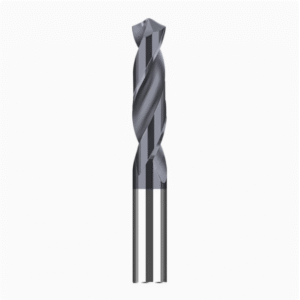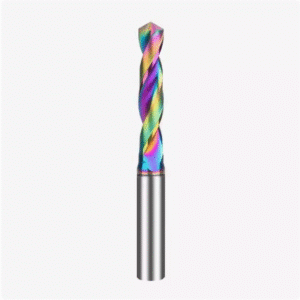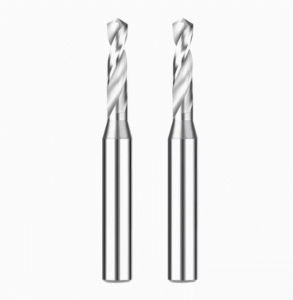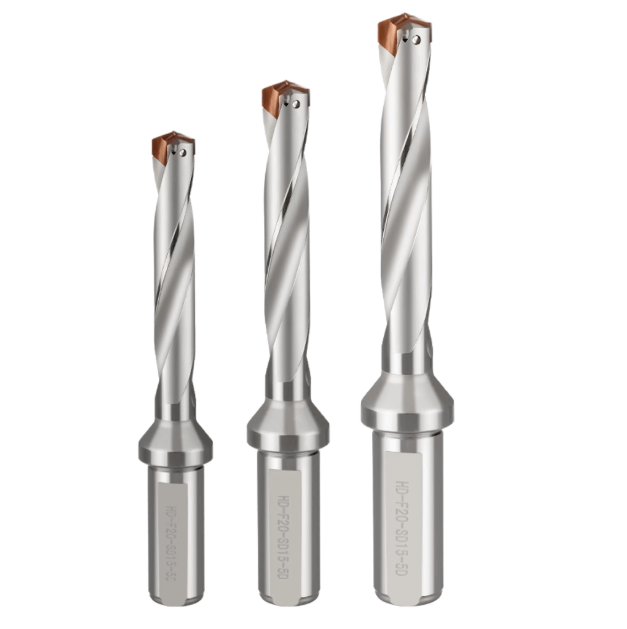When drilling metal, the condition and wear of a drill bit directly affect hole accuracy, surface finish, and overall machining efficiency. Many engineers overlook the gradual degradation of drill bit performance during production, only realizing the problem when hole diameters go out of tolerance, cutting temperatures rise, or machine loads increase abnormally. Promptly identifying the signs that indicate a drill bit needs replacement is critical for maintaining efficient and stable production cycles.
Different types of drill bits—such as carbide drill bits for drilling metal and twist drill bits for metal—have varying lifespans and wear patterns. While tungsten carbide drill bits offer excellent hardness and wear resistance, they can still exhibit chipping and blunting under high loads and temperatures. High-speed steel (HSS) or cobalt alloy drill bits are more prone to thermal fatigue, leading to annealing of the cutting edge. By monitoring wear and adjusting cutting parameters according to drill bit material, drilling depth, and coolant usage, engineers can extend tool life and reduce both downtime and tool costs.
For manufacturers striving for stable mass production, selecting the right drill bit for drilling metal is a long-term strategic decision. Using the wrong drill bit can lead to burrs, misaligned holes, and even scrapped workpieces. When standard drill bits cannot meet specific hole shapes or machining requirements, custom drill bits for drilling metal often provide a better balance of precision, durability, and efficiency.
Understanding the key signals for drill bit replacement, combined with a sound tool selection and maintenance strategy, is crucial for efficient, precise, and controllable metal drilling. This article explores drill bit wear signs, performance degradation indicators, and lifespan patterns across different materials, providing practical guidance on when to replace a drill bit and how to professionally extend its life.

Why Does Drill Bit Wear Directly Affect Metalworking Quality?
Drill bits perform the essential tasks of material removal, cutting, and chip evacuation in metalworking. Their sharpness, geometry, and material properties directly influence hole dimensional accuracy and surface finish. When a drill bit for drilling metal becomes worn or dull, cutting forces increase, causing friction and heat buildup. The drill no longer efficiently “cuts” but instead extrudes the material under high pressure and temperature, damaging the hole surface and potentially causing dimensional deviations and misalignment.
For production lines using carbide drill bits for drilling metal, even though tungsten carbide has excellent wear resistance, long-term high-speed drilling or inadequate cooling can lead to microcrack propagation and cutting edge damage, reducing cutting stability. Tool performance degradation leads to accumulated thermal stress and vibration, affecting the stability of the entire machining process. The following sections detail three key effects of drill bit wear on metalworking quality.
Typical Signs of Decreased Drilling Accuracy and Exceeding Hole Diameter Tolerances
When the main cutting edge or drill tip wears, drilling forces shift, causing center deviation and hole expansion or tapering. For high-precision components, even minor deviations can affect assembly clearance and coaxiality, potentially leading to scrap parts.
With twist drill bits for metal, severe wear of spiral flutes can compromise chip evacuation and unbalance cutting forces, producing issues like chatter marks and edge chipping. Engineers should regularly monitor hole diameters. Deviations beyond tolerance indicate the need for a replacement drill bit.
Causes of Deteriorating Workpiece Surface Roughness
A dull drill cannot efficiently penetrate the material, causing friction and compression that lead to scratches, galling, or burning on the hole wall. Difficult-to-machine metals such as stainless steel or titanium alloys are particularly prone to secondary cutting and material adhesion if the drill bit is not sharp. Insufficient coolant further exacerbates surface roughness. Observing the workpiece’s color, gloss, and tactile feel provides a preliminary indication of cutting edge degradation.
The Chain Reaction of Heat Accumulation and Reduced Cutting Efficiency
During drilling, cutting zone temperatures rise dramatically as friction increases. A worn drill complicates chip formation and evacuation, concentrating heat at the tip and potentially causing thermal cracks in the tool or deformation in the workpiece. This heat buildup not only shortens tool life but also reduces cutting efficiency and may compromise spindle accuracy. For carbide drill bits for drilling metal or custom drill bits for drilling metal, particularly under dry or semi-dry conditions, matching cutting parameters with proper cooling is essential. Neglecting heat accumulation can create a cycle of increasing wear, reduced efficiency, and thermal damage.

Common Wear Signs: When to Replace a Drill Bit
Determining whether a drill bit for drilling metal needs replacement relies not only on visual inspection but also on a combination of indicators such as machining parameters, cutting noise, chip formation, and machine tool feedback. Over time, as the cutting edge wears, changes in geometry occur, and thermal stress accumulates, the drill bit will show signs of reduced cutting performance. Ignoring these signals can result in hole diameter deviations, poor surface finish, or in severe cases, drill bit breakage, workpiece failure, or spindle damage.
These signs are particularly important when using carbide drill bits for drilling metal or twist drill bits for metal. Even though tungsten carbide drill bits are highly hard, microcracks or edge chipping can significantly reduce cutting efficiency. Dull twist drills often lead to poor chip evacuation and heat buildup. The following practical criteria can help engineers determine when to replace a drill bit.
Dulled Drill Tip or Chipped Cutting Edge
The drill tip and main cutting edge are critical to cutting performance. Dullness or chipping significantly reduces drilling efficiency and accuracy. Engineers can evaluate sharpness via visual inspection, reflected light, or microscopic observation.
During high-speed or deep-hole operations, any localized chipping on a carbide drill bit for drilling metal warrants immediate replacement. Continuing use can exacerbate vibration and accelerate tool damage.
Abnormal Chip Morphology
A healthy drilling process produces uniform, predictable chips. When a drill bit wears, chips may become excessively long, break unevenly, or adhere to the cutting edge. This phenomenon is especially common when machining ductile metals such as stainless steel and titanium alloys.
Abnormal chips often indicate high cutting temperatures or obstructed chip evacuation. At this stage, engineers should not only replace the drill bit but also check coolant flow, feed rate, and cutting parameters for proper alignment.
Unusual Noise or Increased Vibration
When the drill bit’s geometry deteriorates or the toolholder is not secure, irregular knocking or high-frequency squealing may occur. Persistent vibration with a twist drill bit for metal, especially when accompanied by scratches or abnormal surface texture, signals tool wear or eccentricity. Excessive vibration affects hole accuracy and accelerates tool fatigue.
Increased Feed Resistance and Machine Load
Worn drill bits increase cutting resistance, raising feed system torque and spindle load. Operators can monitor load on the machine control panel; consistently high readings indicate the drill bit is no longer sharp. Continuing production under these conditions can damage the spindle or break the tool. For mass production, setting alarm thresholds can facilitate preventative replacement.
High Drilling Temperature: Metal Bluing or Burning
Excessive temperature is a clear indicator of drill wear. Blue or brown discoloration on the workpiece indicates overheating, which can harden the hole wall and cause coating flaking. For carbide drill bits for drilling metal or custom drill bits for drilling metal, persistent high temperatures should trigger coolant checks, speed reduction, feed adjustment, and potential tool replacement.

Comparison of Wear Patterns of Drill Bits of Different Materials
Drill bit material directly affects wear resistance, cutting efficiency, and tool life. Common materials for drill bit for drilling metal include tungsten carbide, HSS, cobalt alloy, and twist drill designs. Each material exhibits distinct wear patterns under high-load or adhesive conditions, impacting machining accuracy, surface finish, and tool cost. Engineers should select materials based on machining load, workpiece material, and cooling conditions.
Lifespan and Wear Patterns of Carbide Drill Bits for Drilling Metal
Tungsten carbide drill bits offer high hardness and wear resistance, ideal for hardened steel, stainless steel, and high-hardness alloys. Typical wear modes include:
-
Edge chipping and crack propagation: Microcracks can form at the cutting edge during high-speed or deep-hole drilling, eventually causing chipping.
-
Coating spalling: TiAlN or TiN coatings may flake under high-temperature cutting, reducing anti-sticking performance.
-
Thermal blunting: The cutting edge may soften if cutting parameters are mismatched or coolant is insufficient, leading to increased cutting forces.
By optimizing speed, feed rate, drilling depth ratio, and coolant use, engineers can extend the service life of carbide drill bits for drilling metal, minimizing wear-related hole diameter deviations and surface defects.
Typical Wear Behavior and Maintenance Tips for Twist Drill Bits for Metal
Twist drill bits are widely used due to excellent chip evacuation and stable cutting forces. Common wear signs include:
-
Worn or clogged spiral grooves: Long machining periods with adhesive metals can cause chips to stick, producing uneven cutting forces.
-
Dulled or unevenly worn tips: Cutting edge wear can lead to runout, hole diameter errors, and poor surface finish.
-
Increased vibration: Worn twist drills may resonate, affecting spindle and workpiece accuracy.
Maintenance tips: regularly clean spiral grooves, adjust coolant and cutting parameters, and modify drill tip or helix angles according to material. These measures reduce wear rates and extend tool life.
Comparison of Wear Resistance: HSS vs. Cobalt Drill Bits
-
HSS drill bits: Low cost, high toughness, suitable for medium-soft metals, but prone to blunting. Best for low-speed cutting.
-
Cobalt drill bits: Contain 5%-8% cobalt, improving heat and wear resistance. Suitable for medium-to-high-hardness metals, with edge life 20%-30% longer than HSS.
HSS edges wear evenly but have shorter lifespans; cobalt edges resist heat but may develop microcracks. Proper control of speed, coolant, and cut depth is essential. By analyzing material properties, cutting loads, and machining conditions, engineers can select HSS, cobalt, or carbide drill bits for drilling metal to balance efficiency and tool cost.

Practical Tips for Extending Drill Bit Life
In metal drilling, drill bit life directly affects productivity, machining accuracy, and tool costs. Whether using a carbide drill bit for drilling metal, a twist drill bit for metal, or an HSS/Cobalt drill bit, proper usage and maintenance strategies can significantly extend tool life while reducing downtime and replacement costs. Engineers should focus on four key areas: cutting parameter optimization, cooling management, tool inspection, and material selection. Together, these form a systematic tool management plan.
Optimizing Cutting Parameters
Excessive cutting load or mismatched cutting conditions is a major cause of drill wear. Properly setting RPM, feed rate, and depth-to-diameter ratio helps reduce cutting temperature and forces, slowing edge wear.
-
When machining high-hardness metals like stainless steel or titanium alloys, reduce spindle speed and slightly increase feed rate to minimize tool tip slipping and chip adhesion.
-
For deep-hole drilling, maintain the recommended depth-to-diameter ratio to prevent uneven cutting forces that can cause chipping.
Proper Use of Coolant to Reduce Thermal Stress
Heat is a key factor accelerating drill wear. Correct use of coolant dissipates heat, improves chip evacuation, and prevents workpiece surface burning.
-
For carbide drill bits for drilling metal or custom drill bits, select the coolant type (water-soluble or oil-based) based on the workpiece material.
-
Ensure the spray angle and flow fully cover the drill tip and spiral flutes to minimize thermal stress and extend tool life.
Regularly Check Tool Runout and Concentricity
Tool runout or eccentricity increases local cutting forces, accelerating edge wear. Engineers should regularly inspect drill clamping and spindle runout using gauges or machine measurement systems.
-
Maintaining concentric clamping for twist drill bits for metal or HSS/Cobalt drill bits preserves hole diameter accuracy, reduces vibration damage, and extends tool life.
Avoid Using Incompatible Drill Bits for Metal
Different metals require specific drill bit hardness and edge profiles. Using an incompatible drill, such as an HSS twist drill on hardened steel, leads to rapid wear, increased cutting forces, and potential tool breakage.
-
Consider material hardness, hole diameter, machining depth, and coating type when selecting carbide, cobalt, or HSS drill bits for optimal efficiency and durability.
白底-主图2-300x300.jpg)
How to Choose the Right Drill Bit to Avoid Frequent Drill Bit Replacement
Choosing the right drill bit for drilling metal is crucial for machining efficiency, hole accuracy, and tool life. Frequent drill bit replacements increase production costs, downtime, scrap, and precision fluctuations. Engineers should consider the drill bit’s material, geometry, coating, and the characteristics of the workpiece material, along with cutting parameters and cooling conditions, to develop a sound tool management plan. A proper selection strategy prolongs tool life and improves stability and precision in metalworking.
How to Choose a Drill Bit for Drilling Metal: Material, Geometry, and Coating Considerations
The material directly affects hardness, wear resistance, and thermal stability. Carbide drill bits are ideal for hardened steel, stainless steel, and high-hardness alloys, offering sharp edges and strong wear resistance. HSS and Cobalt drill bits suit medium- and low-hardness metals and provide good toughness.
-
Drill point and helix angles affect cutting force distribution and chip evacuation.
-
Coatings such as TiAlN, TiN, or DLC improve heat resistance and reduce material sticking.
Selecting the right combination ensures consistent drill bit performance across different machining conditions, minimizing edge wear and machining defects.
Key Drill Bit Selection for Different Metals
-
Stainless steel: Carbide drill bits with a smaller helix angle and appropriate coating are recommended. Reduce cutting speeds to prevent edge burning.
-
Aluminum and light alloys: HSS or Cobalt drill bits with a higher helix angle improve chip evacuation and prevent sticking or clogging.
-
Titanium alloys: High-hardness carbide drill bits are preferred. Adjust feed rate and speed, and use efficient cooling to extend tool life.
Tailoring drill bits to the material maintains machining efficiency and reduces frequent replacements.
Carbide, Cobalt, and HSS Material Recommendations
-
Carbide drill bits: High hardness and wear resistance, suitable for hard metals and high-production machining. More expensive, so best for high-value or heavy-load operations.
-
Cobalt drill bits: Longer edge life than HSS, suitable for medium-hard metals and high-temperature conditions, ideal for medium-load, mass production.
-
HSS drill bits: Low cost and excellent toughness for low-hardness metals or intermittent machining. Avoid excessive cutting speeds to prevent dulling.
Following these principles helps engineers select the right material and coating based on metal hardness, hole diameter, depth, and batch size, optimizing machining efficiency and reducing tool changes.

Solutions When Standard Drill Bits Fail to Meet Requirements
For high-precision metalworking or specialized holes, standard drill bits for drilling metal may not meet size, depth, or material requirements. Custom drill bits provide optimized cutting edge profiles, coatings, and geometries, addressing limitations such as poor chip evacuation, rapid wear, or complex hole patterns. They support mass production and high-precision machining efficiently.
Advantages of Custom Drill Bits
-
Adaptable to Special Materials: Tip shapes and coatings for hardened steels, titanium alloys, or composites improve wear resistance and cutting efficiency.
-
Improved Hole Accuracy: Optimized helix angle, cutting edge geometry, and tip angle ensure consistent hole diameters and concentricity, reducing scrap.
-
Extended Tool Life: Customized materials, coatings, and geometry reduce thermal stress and cutting resistance.
-
Optimized Chip Evacuation and Machining Efficiency: Spiral flutes and edge layouts are designed for hole depth and chip type to improve stability in deep-hole and continuous drilling.
Custom drill bits effectively address standard drill limitations, enabling efficient, stable production.
Applications for Special Hole Patterns and High-Precision Machining
-
Non-standard or irregular-shaped holes: Multi-stage tips enable drilling complex holes in one pass.
-
High-aspect-ratio holes: Optimized helix and flute design prevent chip blockages and tip breakage.
-
High-precision machining: Material selection and coatings achieve micron-level control over hole diameter and surface finish.
Custom drill bits solve production bottlenecks where standard drills struggle.
Collaborating with Tool Suppliers
-
Provide detailed machining parameters: material, hole diameter, depth, batch size, and speed.
-
Identify machining challenges: chip evacuation, surface roughness, drill life, heat buildup.
-
Participate in design and verification: run simulations or small-batch tests based on supplier recommendations.
-
Establish feedback mechanisms to optimize custom drill design using real-world machining data.
Systematic collaboration ensures custom drill bits with stable performance, long life, and adaptability to complex conditions.

Timely Replacement of Drill Bits Ensures Efficient, Precise Machining
Drill condition directly affects hole diameter accuracy, surface quality, and production efficiency. Wear signs include blunted tips, chipped edges, abnormal chips, vibration, increased feed resistance, and high-temperature burns. Recognizing these prevents tool failure, downtime, and cost increases.
Material choice affects wear and lifespan:
-
Carbide: High hardness, ideal for hard metals; control cutting heat.
-
Twist drill bits: Require inspection and maintenance for chip evacuation and vibration control.
-
HSS/Cobalt: Medium- and low-hardness metals; adjust speed and feed appropriately.
Custom drill bits provide solutions for high-precision, complex, or high-aspect-ratio holes, improving chip evacuation, hole accuracy, and tool life. Promptly identifying wear, selecting the right material and coating, optimizing cutting parameters and cooling, and employing custom tools ensures efficient, precise, and cost-effective metal drilling.



-白底主图2.jpg)





